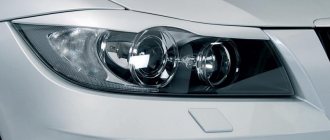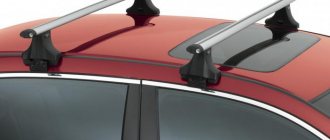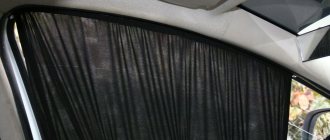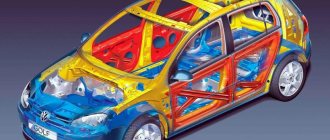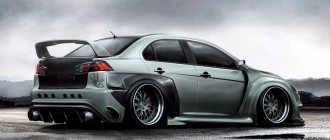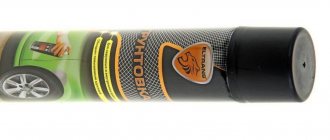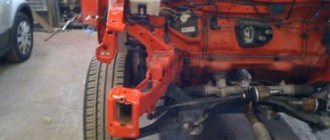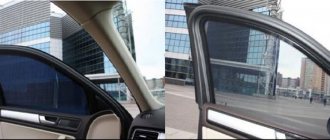Transporting cargo on the roof of a passenger car was widely accepted in the USSR, where renting a truck with a driver was quite difficult; the few cargo taxis could not cope. And Soviet people were accustomed to solving all issues on their own, especially if they had a personal car. Now this is not so relevant, however, the capacity of even a large station wagon or crossover for trips to the country with all the property or long-distance travel is not enough.
It is not difficult to buy a trunk, but the question arises with its fastening; developed gutters along the edges of the roof have long gone out of automotive fashion.
What are car roof rails?
Physically, roof rails are arches of a certain diameter and length that are installed on the roof of the car. They can be supplied as standard for the following body types:
- SUV;
- crossover:
- pickup;
- minivan and minibus;
- station wagon
Rails on the roof of a car
For other types of bodywork, certain places are provided for the installation of transverse or longitudinal rails. Most often, these are technological holes in the roof for the original element, which are closed with plastic plugs. In this case, the driver needs to buy car roof rails separately and attach them himself.
VAZ cars before 2012 are not equipped with standard roof rails; installation of fasteners for luggage bars is carried out independently. Drivers need to drill into metal to install the rack.
What are they needed for
The roof rails on the car play the role of a load-bearing element on which an additional luggage rack is installed. The latter can be:
- frame structure made of open longitudinal or transverse plates;
- closed car box,
- trunk in the form of a loading area;
- special cross mount for bicycles;
- open basket.
If you install integrated rails, you can pack the things necessary for transportation without installing crossbars, for example, when transporting building materials or large items.
Roof rails Kia Sportage
Types of roof rails
Roof rails are classified:
- according to the material of manufacture;
- design;
- by type of installation.
For the manufacture of roof rails, steel, plastic and metal-plastic are used. Steel structures are installed to transport heavy loads. They provide grip rigidity and reliable transportation. Universal types of roof rails can be mounted on any car of suitable dimensions.
Model designs are designed for installation on a specific make of car, often for a specific year of manufacture. For example, the Nissan X-Trail after 2015 is equipped with standard model roof rails with an additional headlight, which are not suitable for installation on other models of this class.
Plastic elements are equipped with crossbars. The peculiarity of this type of trunk is that it is easy to remove. Plastic arches are installed under closed car boxes; the design of the trunk allows you to evenly distribute the weight of the luggage.
Why is it better to entrust the installation of the trunk to professionals?
- Specialists will perform all the work competently. They know about the features of different cars and take them into account. There will be no damage to your car when installing the rack.
- Experts can recommend you a trunk in advance that matches the parameters of your car. This will also minimize the risk of damage and simplify further transportation of any cargo.
- Specialists know how to install the trunk so that, together with the cargo, it does not have a negative impact on such important parameters of movement as safety and dynamics.
Design
Before installing the rails, determine the diameter, length and design of the structure. By type, arcs are divided into:
- rectangular;
- aerodynamic.
A rectangular railing is a metal or steel profile covered with a plastic casing. The rectangular profile has a simple design, it is easy to remove, installation is carried out with bolts or special fasteners.
Rectangular roof rails
The disadvantage of the standard bar is that the trunk makes noise at speeds above 80 km/h, and there is excessive fuel consumption due to poor aerodynamic performance.
Aerodynamic integrated roof rails are made of anodized aluminum and weigh up to 3 kg. They do not create additional aerodynamic drag and do not create noise at speeds above 80 km/h. Installation of the structure - on fastening sleeves.
Advantages and disadvantages
Rails perfectly solve the problem of transporting suitcases, camping equipment, fishing equipment and much more. They are better than trailers because they do not reduce the maneuverability of the vehicle. A driver who is stopped by a traffic cop on the road for not working lights will not have a question about where the trailer with his wife and four children is. It is also important that roof rails are cheaper than a trailer and do not require special license plates.
Rails securely secure bicycles, strollers and other loads. If desired, the driver has the opportunity to install baskets on them. Additionally, it can be reinforced with an airbox - a protective coating against precipitation and road dust. They are easy to install and remove depending on need. They also do not interfere with the installation of additional equipment.
There are elements and shortcomings. The risk of cargo damage due to vehicle rollover is much higher. Keeping hanging equipment safe is also not that easy. It is also necessary to tighten the fastenings in time.
Classification by installation method
Installation of roof rails depends on the specific model of the trunk. The most common classification remains:
- longitudinal;
- transverse arcs.
Longitudinal rails are installed on the roof in the drainage area. Transverse rods are attached to the arches. What are these roof rails needed for? - for transporting large-sized, non-standard cargo. The rods are attached to the longitudinal arches through locking fasteners. Depending on the size of the roof and the transportation option, you can remove the middle bar or install an additional one by selecting the desired distance between the crossbars.
Transverse structures are two- and three-support arches that are mounted across the roof. For station wagons and liftbacks, the installation of four transverse arches or longitudinal integrated roof rails is provided.
Integrated roof rails are an arc, after installation of which there is no free space left between the roof and the element. The arches are most often installed at the factory; they have only a model version and are not intended for reinstallation on other brands of cars.
The rack is designed for installation on a flat roof. The kit includes an integrated lock or fastener that is mounted in the doorway.
Mounting type
Roof racks can be divided into 4 main groups, according to the type of installation:
- Integrated roof rails. These are standard or independently installed longitudinal arches that do not have any clearance between the roof.
- With clearance. The type of rack mounting directly depends on the amount of clearance between the roof and the arches.
- Installation in standard places. In this case, the owner can only purchase roof rails designed specifically for his car (model) or universal (sliding).
- Fastening to a doorway. This is a class of universal, transverse roof rails that provide for the installation of a roof rack on a straight roof, without drilling holes.
Installation features
Installation of roof rails can be carried out:
- in standard places on the roof of the car;
- into the doorway after preparing the body.
Integrated roof rails are installed only in standard places. The original arches have special stops that are installed in holes on the roof. The set of original roof rails includes adapters that are designed for a specific model.
Installation of roof rails
If the car model does not have places provided for standard roof rails, drivers either use sets of arches for installation on the doorway, or drill technological holes in the roof for fasteners.
Rails for flat roofs have a large area of supporting arches. During installation, it is necessary to carry out anti-corrosion treatment, since the corrosion process may begin where the bolts enter the metal of the body.
Important points
You can install the additional trunk yourself with a minimum of tools. Important installation features:
- Remove the plugs for the standard holes for the trunk according to the marks on the parts.
- Clean the seat under the railing, degrease it, and treat it with silicone sealant. This will prevent corrosion and moisture from penetrating under the roof metal.
- Install the required type of railing according to the instructions.
Nuances of installation and operation
You can install the roof rails yourself. If the vehicle manufacturer provides for the installation of fastening elements, then the motorist will need:
- Find holes on the roof of the car intended for installing arches. They are closed with special rubber plugs.
- To remove the plugs, you will need to pull them to the side marked with arrows on the rubber elements and pull them up.
- The freed holes are thoroughly washed and degreased. Next, silicone sealant for external use is applied to the seats. This operation needs to be given special attention: if it is poorly handled during operation of a car with roof rails, moisture will penetrate through the roof of the car into the vehicle interior.
- Upon completion of the preparatory work, the roof rails are fixed to the roof of the car in accordance with the design of the products.
Using roof rails you can transport large cargo.
If the standard design of the vehicle does not provide for the installation of roof rails, you will need:
- Clean the work surface from dirt and dust, degrease it.
- Remove the trim from the interior ceiling.
- Drill holes in the ceiling. When performing the operation, take into account the location of future seats for attaching the rails.
- Install the roof rails and carefully secure them to the roof.
Self-installation of roof rails on a model where the use of this product is not provided for by the design implies their constant use, as holes will be made in the roof of the vehicle.
When using roof rails, it is recommended to observe the following rules:
- after installing the arcs, they can be used a day after installation is completed;
- Before each use of the vehicle, check the strength of the fastening of the roof rails to the car body;
- the transported cargo is evenly distributed over the entire surface of the additional luggage container and the quality of securing the transported goods is strictly monitored;
- The maximum permissible load capacity must not be exceeded.
You cannot transport cargo with a total weight of more than 70-80 kilograms on roof rails. Due to overload, car doorways may become deformed or the roof may become skewed.
Tips for choosing roof rails for a car
When installing an additional roof rack, it is necessary to take into account the main requirements when choosing roof rails. Tips before purchasing:
- Determine what type of roof rails, longitudinal or transverse, is provided by the manufacturer for the car. For SUVs and pickups, both transverse and longitudinal are offered, for other classes - only longitudinal.
- If the factory does not provide places for attaching the luggage bar, choose only transverse structures that are suitable in length.
- Take into account the load on the railing. Plastic arches can withstand weight up to 40 kg, aluminum – up to 60 kg, steel – up to 90 kg.
- When choosing universal types of roof rails that can be installed on cars of various classes, the size of the roof and the number of fasteners on the arch are taken into account. Manufacturers indicate in the trunk passport the compatibility of the roof rail with a certain class of car.
Many drivers have already appreciated the convenience and usefulness of roof rails. Quite often, the trunk is not removed after use, rightly believing that the minimum weight and the absence of aerodynamic load do not affect the dynamics of the car and improve its appearance.
Statement of a question
Railings are a continuation of the trunks of predominantly Soviet cars. Roof racks were far from perfect and were not always aerodynamically efficient. We also had to worry about the safety of the cargo - it could fall completely unexpectedly.
The solution was built-in luggage racks. The impact on the dynamics of air flows has decreased and become almost zero. The design change made it possible to improve the aesthetics of the vehicle design without compromising functionality. Thanks to this, roof rails have become firmly established among motorists. They can be seen on hatchbacks and station wagons.
